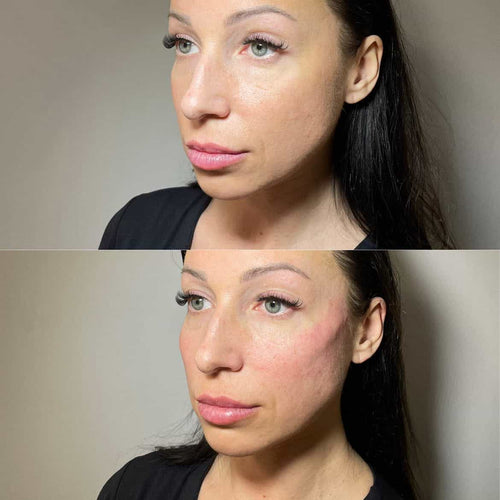Book a Dermal Filler Appointment at It’s Me and You Clinic with Dr. Laura Geige
Signs You Might Have Lip Filler Migration
Asymmetry or Shifting Shape
Lip filler migration occurs when hyaluronic acid gel used during lip augmentation spreads from its intended location. This can cause an unnatural appearance, distortion, or even lumps and bumps.
Recognizing the signs of lip filler migration is crucial for addressing it promptly. Here are some key indicators:
1. **Lumps or Bumps:** One of the most noticeable signs is the appearance of hard or soft lumps in your lips, often appearing where the filler wasn’t initially placed.
2. **Asymmetry:** If your lips previously looked symmetrical and now appear uneven or one lip looks noticeably different from the other, it could indicate migration.
3. **Loss of Definition:** The defined shape you achieved with filler may become blurred or less pronounced. Lip lines might seem undefined, and the overall plumpness can appear uneven.
4. **Filler Movement:** Touching your lips gently might reveal that the filler feels mobile or movable under the skin, suggesting it’s not fixed in its intended position.
5. **Discomfort:** You may experience increased tenderness, pain, or even a burning sensation in areas where the filler has migrated.
6. **White Patches:** In some cases, you might notice small, white patches on your lips, indicating that the hyaluronic acid is being pushed into different layers of the skin.
7. **Filler “Blurring”:** If the edges of your lip enhancement appear blurry or indistinct rather than sharp and defined, migration could be a factor.
It’s important to consult with a qualified medical professional experienced in dermal fillers if you suspect migration. They can accurately diagnose the issue and discuss appropriate treatment options, which may involve dissolving the filler or revising the injection placement.
Lumps or Nodules
Lip filler migration occurs when the hyaluronic acid gel injected into your lips moves from its intended location. This can happen for various reasons, including improper injection technique, excessive movement in the area, or natural breakdown of the filler over time.
While lip fillers generally provide subtle and long-lasting enhancements, recognizing signs of migration is crucial for addressing potential complications. Here are some telltale indicators that your lip filler might have migrated:
Reserve a Dermal Filler Appointment with Dr. Laura Geige
-
Asymmetry: If one lip appears larger or fuller than the other, it could indicate uneven distribution of the filler, suggesting migration.
-
Blurred Definition: The clear outline of your lips may become less defined if the filler has spread beyond the intended area. You might notice a softer, less contoured appearance.
-
Puckering or Distortion:
-
The migrated filler can distort the natural shape of your lips, causing them to appear puckered, stretched, or uneven in places.
-
Nodules or Lumps: These are small, hardened bumps that form beneath the skin where the filler has clumped together. They can feel tender or painful to touch.
-
Filler “Beading”: In some cases, migrated filler might appear as distinct beads or lumps rather than a smooth, even contour.
-
Increased Volume in Unexpected Areas: If you notice excessive fullness in areas beyond your lips, like the surrounding skin of your face, it could indicate migration.
If you suspect lip filler migration, it’s crucial to consult a qualified medical professional who specializes in aesthetic injectables. They can assess the situation and recommend appropriate treatment options.
Book a Dermal Filler Consultation with Dr. Laura Geige at It’s Me and You Clinic
Blurred Borderlines
Lip filler migration occurs when the hyaluronic acid gel injected into the lips moves from its intended location, often resulting in an unnatural or distorted appearance.
Here are some signs that you might have lip filler migration:
1. Blurred Borderlines: A key indicator is a loss of definition and a blurring of the natural lip border. The lines between your lips and your skin may become indistinct, making your lips appear larger or oddly shaped.
2. Asymmetry: If you notice that one side of your lips looks fuller or differently shaped than the other, migration could be the culprit. The filler may have moved unevenly during the injection process or over time.
3. “Smocked” Appearance: Migration can sometimes cause a “smocked” or stretched-out look to the lips. This occurs when the filler spreads excessively beneath the skin, distorting the natural contours.
4. Lumpy Texture: If your lips feel bumpy or uneven, even after they’ve settled, it could be due to migrated filler clumping together.
5. Filler in Unintended Areas: In rare cases, migrated filler may spread beyond the lip area and appear in nearby tissues, such as the cheeks or chin. This can cause swelling and discomfort in those regions.
If you suspect you have lip filler migration, it’s crucial to consult a qualified dermatologist or plastic surgeon experienced in injecting fillers. They can assess your situation and discuss potential treatment options, which may involve dissolving the migrated filler with an enzyme called hyaluronidase.

Why Does Lip Filler Migrate?
Incorrect Injection Technique
Lip filler migration occurs when hyaluronic acid, the common ingredient in lip fillers, moves from its initial injection site.
This can happen for various reasons, but a primary culprit is improper injection technique.
Here’s how incorrect injection methods can lead to migration:
**Incorrect Needle Angle:**
Injecting at too shallow an angle can cause the filler to spread superficially and easily migrate into surrounding tissues.
The needle should be inserted at a slightly oblique angle, following the natural contours of the lip.
Overfilling or Excessive Volume:
Injecting too much filler creates pressure that can push it beyond its intended location.
This can lead to ballooning, distortion, and migration into nearby areas like the vermilion border or cheeks.
**Improper Spreading:**
After injection, proper spreading of the filler is crucial to distribute it evenly and prevent pooling.
If not spread adequately, the filler can clump together, creating a higher risk of migration.
Insufficient Depth:
Injecting too superficially places the filler where it’s more susceptible to movement.
The ideal depth varies depending on the desired result but generally involves injecting deeper into the lip tissues for longevity and less migration.
**Needle Movement:**
Excessive or erratic needle movements during injection can disrupt the surrounding tissue structure, making it easier for the filler to migrate.
Smooth, controlled injections minimize this risk.
It’s essential to choose a qualified and experienced injector who understands proper lip filler techniques to minimize the chance of migration.
Natural Body Movement
Lip filler migration occurs when the injected hyaluronic acid gel, used to enhance lip volume, moves from its initial placement.
This can happen due to natural body movement and certain factors influencing the filler’s integration with surrounding tissues.
Natural Body Movement plays a significant role in filler migration. The lips are highly mobile, constantly contracting, stretching, and expressing emotions.
These movements exert pressure on the injected gel, causing it to shift over time. Speaking, laughing, smiling, and even breathing can contribute to this movement.
The durability of certain fillers also influences migration. Some hyaluronic acid gels are designed to be more resilient and resist movement than others.
The injector’s skill and the patient’s individual anatomy also impact the likelihood of migration. Proper injection techniques, tailored to the patient’s specific lip structure, can minimize movement.
Understanding these factors is crucial for patients seeking lip augmentation.
What To Do About Migrated Lip Filler
Seek Professional Advice
Lip filler migration occurs when injected hyaluronic acid (HA) filler moves from its intended location, causing lumps, bumps, or distortion in the lips.
If you suspect your lip filler has migrated, seeking professional advice is crucial.
First, **consult a qualified and experienced injector** who specializes in dermal fillers. They will examine your lips thoroughly to determine if migration has occurred and assess its severity.
Based on the findings, the injector may recommend one or more of the following:
Dissolving the Filler:**
A medication called hyaluronidase can be injected directly into the migrated filler to break it down. This process is generally safe and effective but may require multiple sessions.
**Re-injecting Filler:**
If the migration is minor, the injector may choose to carefully re-inject some filler to restore symmetry and shape.
Massage Therapy:
In some cases, gentle massage of the affected area under the guidance of a professional might help redistribute the migrated filler.
It’s important to note that attempting to treat migrated lip filler yourself can be dangerous and could worsen the situation.
Avoid squeezing or massaging the area excessively, as this could further spread the filler and lead to complications.
Follow your injector’s post-treatment instructions carefully to minimize any potential risks and ensure optimal healing.
Dissolving the Filler
Migrated lip filler, where hyaluronic acid filler moves from its intended placement, can be concerning. Here’s what to do about it and how dissolving the filler might be an option.
First, it’s crucial to consult with a qualified and experienced injector who specializes in dermal fillers.
They can accurately assess the situation and recommend the best course of action.
-
Evaluation:
-
The injector will examine your lips, looking for asymmetry, lumps, bumps, or areas of filler that feel different than usual. They may also ask you about your medical history and the details of your previous lip filler procedure.
-
Dissolving the Filler:
-
Hyaluronic acid fillers can be dissolved using an enzyme called hyaluronidase.
-
This medication breaks down the hyaluronic acid molecules, allowing them to be reabsorbed by the body. The dissolving process may take multiple sessions depending on the amount of filler that needs to be removed.
-
Mild side effects of hyaluronidase injections can include redness, swelling, bruising, and pain at the injection site.
-
It’s important to follow your injector’s post-treatment instructions carefully to minimize these risks.
-
After dissolving the filler, you may experience some temporary swelling or bruising.
-
Your lips will gradually return to their normal shape as the filler is absorbed by your body.
Potential Side Effects:
Recovery and Results:
Couture Lust Couture Lust Raindrops and Ribbons Made by Penny Ayiti Natives
- Brow Lift Treatment Near Abinger, Surrey - April 26, 2025
- How Much Is 05ml Lip Filler Uk - April 26, 2025
- How Do I Know If My Lip Filler Has Migrated - April 25, 2025
